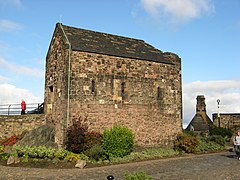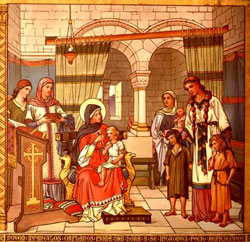
Feastday: November 16
Patron: of Scotland
Birth: 1045
Death: 1093
Canonized: 1250 by Pope Innocent IV
St. Margaret of Scotland, or Margaret of Wessex, was an English princess born in Hungary to Princess Agatha of Hungary and English Prince Edward the Exile around 1045. Her siblings, Cristina and Edgar the Atheling were also born in Hungary around this time.
Margaret and her family returned to England when she was 10-years-old and her father was called back as a potential successor to the throne. However, Edward died immediately after the family arrived, but Margaret and Edgar continued to reside at the English court.
Margaret's family fled from William the Conqueror after his victory at the Battle of Hastings in 1066. Her widowed mother set out to take her children north to Northumbria.
Tradition says, Agatha decided to leave Northumbria and return to the continent, but her family's ship got caught in a storm. The storm drove their ship even more north to Scotland, where they were shipwrecked in 1068. The spot they landed on is now known as "St. Margaret's Hope."
Malcolm Canmore III, the king of Scotland, welcomed Margaret and her family and put them under his protection. He soon fell deeply in love with the beautiful and kind princess. Margaret and Malcolm became married in 1070 at the castle of Dunfermline.
Together, they had eight children, six sons and two daughters. All of whom were raised with deep Catholic Christian faith. They lived as a holy family, a domestic church.
Margaret's kind-nature and good heart was a strong influence on Malcolm's reign. She softened his temper and helped him become a virtuous King of Scotland. Together they prayed, fed the hungry, and offered a powerful example of living faith in action. Margaret was placed in charge of all domestic affairs and was often consulted with state matters, as well.
She promoted the arts and education in Scotland. She encouraged Church synods and was involved in efforts to correct the religious abuses involving Bishops, priests and laypeople.
Her impact in Scotland led her to being referred to as, "The Pearl of Scotland."
She constantly worked to aid the poor Scotland. She encouraged people to live a devout life, grow in prayer, and grow in holiness. She helped to build churches, including the Abbey of Dunfermline, where a relic of the true Cross is kept. She was well-known for her deep life of prayer and piety. She set aside specific times for prayer and to read Scripture. She didn't eat often and slept very little so she would have more time for her devotions. She lived holiness of life as a wife, mother and lay woman; truly in love with Jesus Christ.
Malcolm supported Margaret in all her endeavors and admired her religious devotion so much he had her books decorated in jewels, gold and silver. One of these decorated books, a gospel book with portraits of the four evangelists, is now kept in Oxford at the Bodleian Library after it was miraculously recovered from a river.
In 1093, Malcolm and their oldest son were killed during the Battle of Alnwick. Already ill and worn from a life full of austerity and fasting, Margaret passed away four days after her husband, on November 16, 1093.
Her body was buried before the high alter at Dunfermline.
In 1250, Pope Innocent IV canonized Margaret as a Saint, acknowlegeing her life of holiness and extraordinary virtue. She was honored for her work for reform of the Church and her personal holiness.
In 1259, Margaret's and Malcolm's bodies were transferred to a chapel in the eastern apse of Dunfermline Abbey. In 1560, Mary Queen of Scots came into possession of Margaret's head. It was kept as a relic. She insisted that it, and Margaret's prayers from heaven, helped assist her in childbirth. Her head later ended up with the Jesuits at the Scots' College, Douai, France, but was lost during the French Revolution.
St. Margaret is the patron saint of Scotland and her feast day is celebrated on November 16.
English princess and Scottish queen
Saint Margaret of Scotland (Scots: Saunt Magret, c. 1045 – 16 November 1093), also known as Margaret of Wessex, was an English princess and a Scottish queen. Margaret was sometimes called "The Pearl of Scotland". Born in the Kingdom of Hungary to the expatriate English prince Edward the Exile, Margaret and her family returned to England in 1057. Following the death of king Harold II at the Battle of Hastings in 1066, her brother Edgar Ætheling was elected as King of England but never crowned. After she and her family fled north, Margaret married Malcolm III of Scotland by the end of 1070.
She was a very pious Christian, and among many charitable works she established a ferry across the Firth of Forth in Scotland for pilgrims travelling to St Andrews in Fife, which gave the towns of South Queensferry and North Queensferry their names. Margaret was the mother of three kings of Scotland, or four, if Edmund of Scotland (who ruled with his uncle, Donald III) is counted, and of a queen consort of England. According to the Vita S. Margaritae (Scotorum) Reginae (Life of St. Margaret, Queen (of the Scots)), attributed to Turgot of Durham, she died at Edinburgh Castle in Edinburgh, Scotland in 1093, merely days after receiving the news of her husband's death in battle.
In 1250, Pope Innocent IV canonized her, and her remains were reinterred in a shrine in Dunfermline Abbey in Fife, Scotland. Her relics were dispersed after the Scottish Reformation and subsequently lost. Mary, Queen of Scots, at one time owned her head, which was subsequently preserved by Jesuits in the Scots College, Douai, France, from where it was subsequently lost during the French Revolution.
Early life
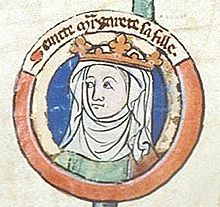 Margaret from a medieval family tree
Margaret from a medieval family tree
Margaret was the daughter of the English prince Edward the Exile and his wife Agatha, and also the granddaughter of Edmund Ironside, King of England. After the death of Ironside in 1016, Canute sent the infant Edward and his brother to the court of the Swedish king, Olof Skötkonung, and they eventually made their way to Kiev. As an adult, he travelled to Hungary, where in 1046 he supported the successful bid of King Andrew I for the Hungarian crown. The provenance of Margaret's mother, Agatha, is disputed, but Margaret was born in Hungary about 1045. Her brother Edgar the Ætheling and sister Cristina were also born in Hungary around this time. Margaret grew up in a very religious environment in the Hungarian court.
Return to England
Still a child, she came to England with the rest of her family when her father, Edward the Exile, was recalled in 1057 as a possible successor to her great-uncle, the childless King Edward the Confessor. Whether from natural or sinister causes, her father died immediately after landing, and Margaret continued to reside at the English court where her brother, Edgar Ætheling, was considered a possible successor to the English throne. When Edward the Confessor died in January 1066, Harold Godwinson was selected as king, possibly because Edgar was considered too young. After Harold's defeat at the Battle of Hastings later that year, Edgar was proclaimed King of England, but when the Normans advanced on London, the Witenagemot presented Edgar to William the Conqueror, who took him to Normandy before returning him to England in 1068, when Edgar, Margaret, Cristina, and their mother Agatha fled north to Northumbria, England.
Journey to Scotland
According to tradition, the widowed Agatha decided to leave Northumbria, England with her children and return to the continent. However, a storm drove their ship north to the Kingdom of Scotland, where they were shipwrecked in 1068. There they were given refuge by King Malcolm III. The locus where it is believed that they landed is known today as St Margaret's Hope, near the village of North Queensferry, Fife, Scotland. Margaret's arrival in Scotland, after the failed revolt of the Northumbrian earls, has been heavily romanticized, though Symeon of Durham implied that her first meeting of Malcolm III may not have been until 1070, after William the Conqueror's Harrying of the North. Other sources say they met 9 years before. According to Orderic Vitalis, one of Malcolm's earliest actions as king was to travel to the court of Edward the Confessor in 1059 to arrange a marriage with 'Edward's kinswoman Margaret, who had arrived in England two years before from Hungary'. If a marriage agreement was made in 1059, it was not kept, and this may explain the Scots invasion of Northumbria in 1061 when Lindisfarne was plundered.
King Malcolm III was a widower with two sons, Donald and Duncan. He would have been attracted to marrying one of the few remaining members of the Anglo-Saxon royal family. The marriage of Malcolm and Margaret occurred in 1070. Subsequently, Malcolm executed several invasions of Northumberland to support the claim of his new brother-in-law Edgar and to increase his own power. These, however, had little effect save the devastation of the County.
Progeny
Margaret and Malcolm had eight children – six sons and two daughters:
- Edward (c. 1071 – 13 November 1093), killed along with his father in the Battle of Alnwick
- Edmund (c.1071 – post 1097)
- Ethelred, abbot of Dunkeld, Perth and Kinross, Scotland
- Edgar (c.1074 – 11 January 1107), king of Scotland, reigned 1097–1107
- Alexander I (c.1078 – 23 April 1124), King of Scotland, reigned 1107–24
- Edith (c. 1080 – 1 May 1118), renamed Matilda, queen of England
- Mary (1082–1116), countess of Boulogne
- David I (c.1084 – 24 May 1153), king of Scotland, reigned 1124–53
Piety
 Malcolm greeting Margaret at her arrival in Scotland; detail of a mural by Victorian artist William Hole
Malcolm greeting Margaret at her arrival in Scotland; detail of a mural by Victorian artist William Hole
Margaret's biographer Turgot of Durham, Bishop of St. Andrew's, credits her with having a civilizing influence on her husband Malcolm by reading him narratives from the Bible. She instigated religious reform, striving to conform the worship and practices of the Church in Scotland to those of Rome. This she did on the inspiration and with the guidance of Lanfranc, a future archbishop of Canterbury. She also worked to conform the practices of the Scottish Church to those of the continental Church, which she experienced in her childhood. Due to these achievements, she was considered an exemplar of the "just ruler", and moreover influenced her husband and children, especially her youngest son, the future King David I of Scotland, to be just and holy rulers.
"The chroniclers all agree in depicting Queen Margaret as a strong, pure, noble character, who had very great influence over her husband, and through him over Scottish history, especially in its ecclesiastical aspects. Her religion, which was genuine and intense, was of the newest Roman style; and to her are attributed a number of reforms by which the Church [in] Scotland was considerably modified from the insular and primitive type which down to her time it had exhibited. Among those expressly mentioned are a change in the manner of observing Lent, which thenceforward began as elsewhere on Ash Wednesday and not as previously on the following Monday, and the abolition of the old practice of observing Saturday (Sabbath), not Sunday, as the day of rest from labour (see Skene's Celtic Scotland, book ii chap. 8)." The later editions of the Encyclopædia Britannica, however, as an example, the Eleventh Edition, remove Skene's opinion that Scottish Catholics formerly rested from work on Saturday, something for which there is no historical evidence. Skene's Celtic Scotland, vol. ii, chap. 8, pp. 348–350, quotes from a contemporary document regarding Margaret's life, but his source says nothing at all of Saturday Sabbath observance, but rather says St. Margaret exhorted the Scots to cease their tendency "to neglect the due observance of the Lord's day."
She attended to charitable works, serving orphans and the poor every day before she ate and washing the feet of the poor in imitation of Christ. She rose at midnight every night to attend the liturgy. She successfully invited the Benedictine Order to establish a monastery in Dunfermline, Fife in 1072, and established ferries at Queensferry and North Berwick to assist pilgrims journeying from south of the Firth of Forth to St. Andrew's in Fife. She used a cave on the banks of the Tower Burn in Dunfermline as a place of devotion and prayer. St. Margaret's Cave, now covered beneath a municipal car park, is open to the public. Among other deeds, Margaret also instigated the restoration of Iona Abbey in Scotland. She is also known to have interceded for the release of fellow English exiles who had been forced into serfdom by the Norman conquest of England.
Margaret was as pious privately as she was publicly. She spent much of her time in prayer, devotional reading, and ecclesiastical embroidery. This apparently had considerable effect on the more uncouth Malcolm, who was illiterate: he so admired her piety that he had her books decorated in gold and silver. One of these, a pocket gospel book with portraits of the Evangelists, is in the Bodleian Library in Oxford, England.
Malcolm was apparently largely ignorant of the long-term effects of Margaret's endeavours, not being especially religious himself. He was content for her to pursue her reforms as she desired, which was a testament to the strength of and affection in their marriage.
Death
Her husband Malcolm III, and their eldest son Edward, were killed in the Battle of Alnwick against the English on 13 November 1093. Her son Edgar was left with the task of informing his mother of their deaths. Not yet 50 years old, Margaret died on 16 November 1093, three days after the deaths of her husband and eldest son. The cause of death was reportedly grief. She was buried before the high altar in Dunfermline Abbey in Fife, Scotland. In 1250, the year of her canonization, her body and that of her husband were exhumed and placed in a new shrine in the Abbey. In 1560, Mary Queen of Scots had Margaret's head removed to Edinburgh Castle as a relic to assist her in childbirth. In 1597, Margaret's head ended up with the Jesuits at the Scots College, Douai, France, but was lost during the French Revolution. King Philip of Spain had the other remains of Margaret and Malcolm III transferred to the Escorial palace in Madrid, Spain, but their present location has not been discovered.
Veneration
Canonization and feast day
Pope Innocent IV canonized St. Margaret in 1250 in recognition of her personal holiness, fidelity to the Roman Catholic Church, work for ecclesiastical reform, and charity. On 19 June 1250, after her canonisation, her remains were transferred to a chapel in the eastern apse of Dunfermline Abbey in Fife, Scotland. In 1693 Pope Innocent XII moved her feast day to 10 June in recognition of the birthdate of the son of James VII of Scotland and II of England. In the revision of the General Roman Calendar in 1969, 16 November became free and the Church transferred her feast day to 16 November, the date of her death, on which it always had been observed in Scotland. However, some traditionalist Catholics continue to celebrate her feast day on 10 June.
She is also venerated as a saint in the Anglican Church.
Margaret is remembered in the Church of England with a Lesser Festival on 16 November.
Institutions bearing her name
See also: Church of St Margaret of Scotland, Twickenham; St Margaret the Queen, Buxted; St Margaret's Chapel, Edinburgh; and St Margaret of Scotland, AberdeenSeveral churches throughout the world are dedicated in honour of St Margaret. One of the oldest is St Margaret's Chapel in Edinburgh Castle in Edinburgh, Scotland, which her son King David I founded. The Chapel was long thought to have been the oratory of Margaret herself, but is now thought to have been established in the 12th century. The oldest edifice in Edinburgh, it was restored in the 19th century and refurbished in the 1990s. Numerous other institutions are named for her as well.
-
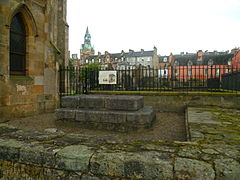
Site of the ruined Shrine of St. Margaret at Dunfermline Abbey, Fife, Scotland
-
St Margaret's Chapel in Edinburgh Castle, Edinburgh, Scotland]
-
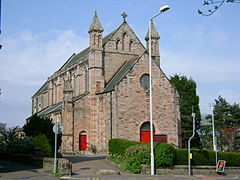
St Margaret's Church in Dunfermline, Fife, Scotland

